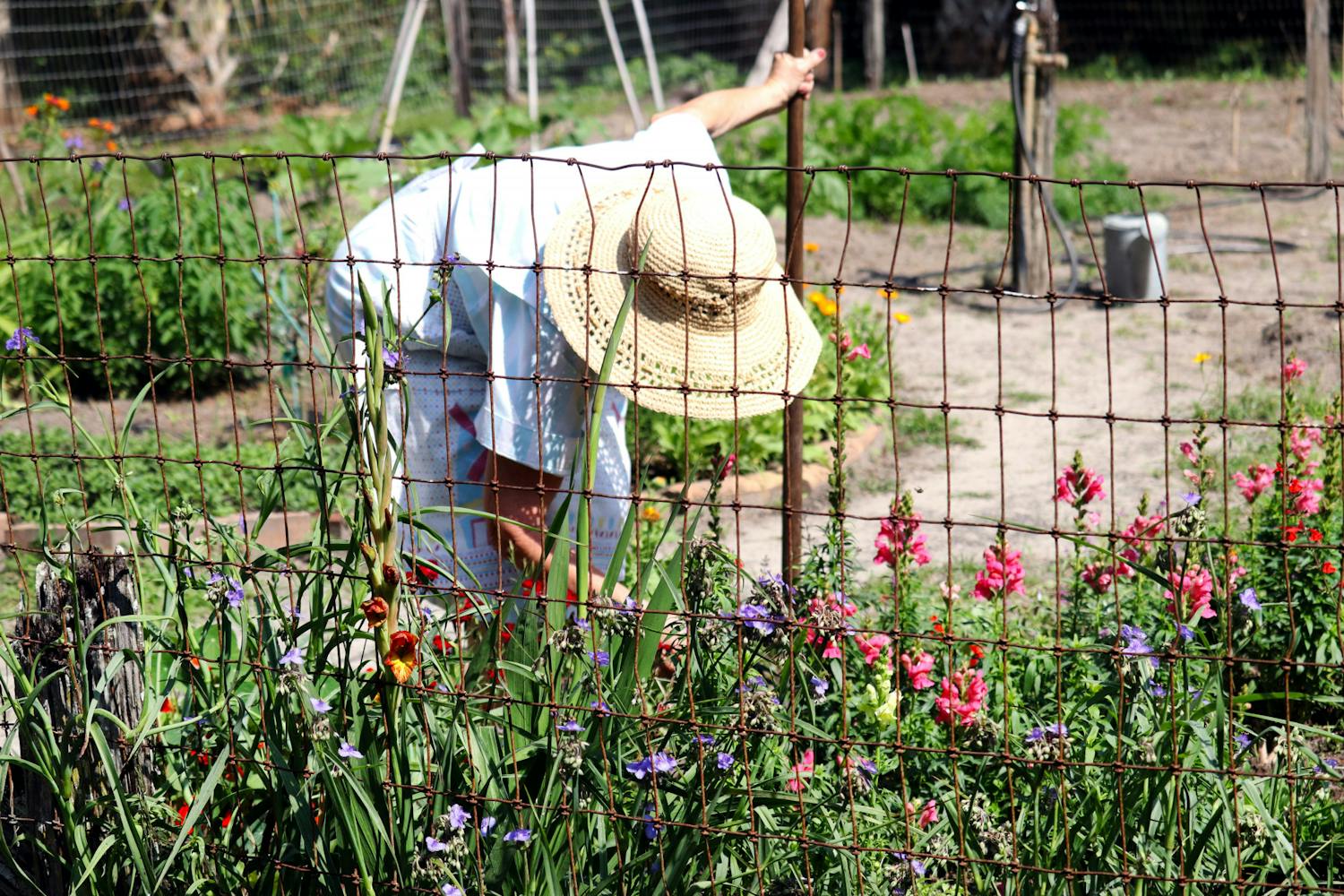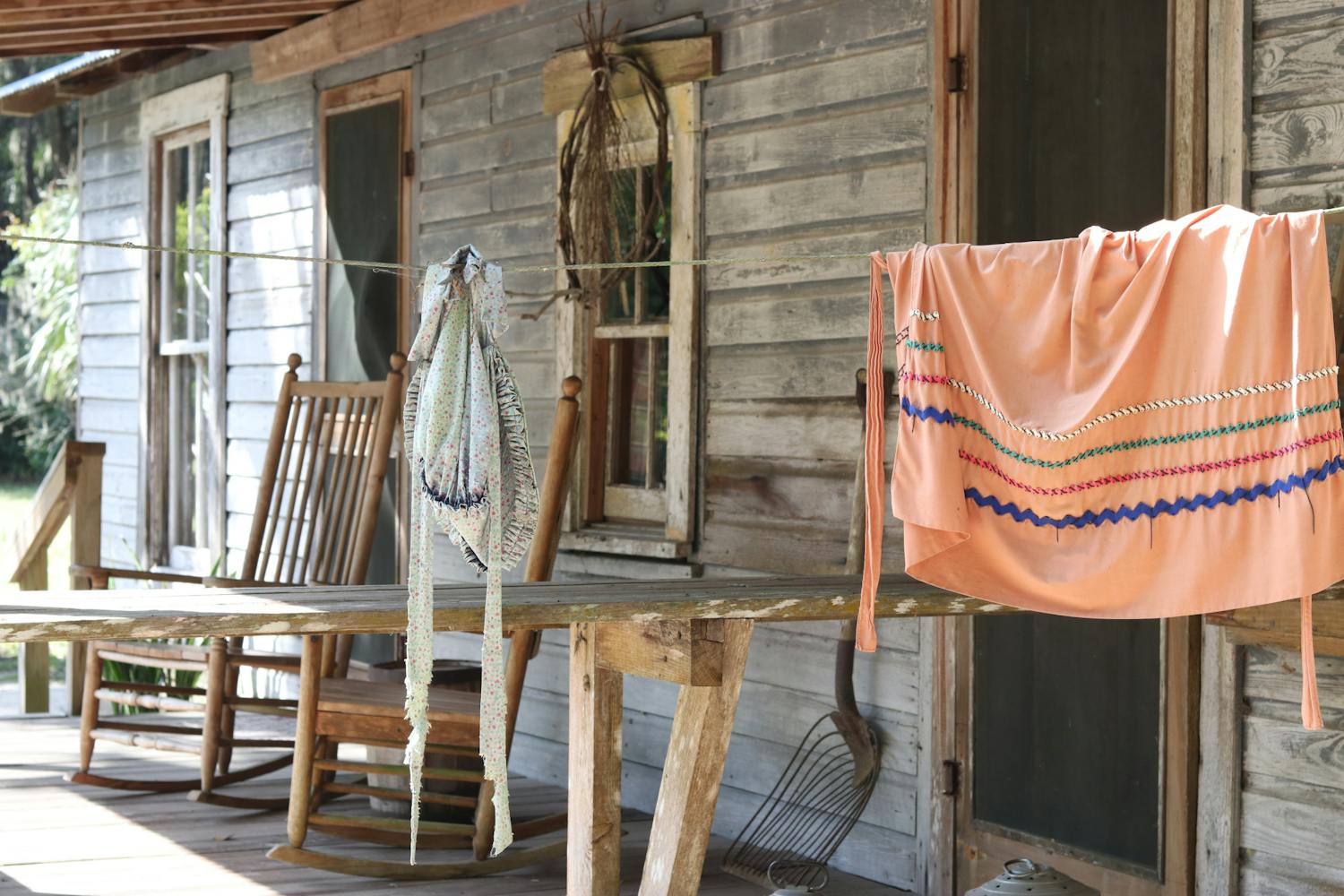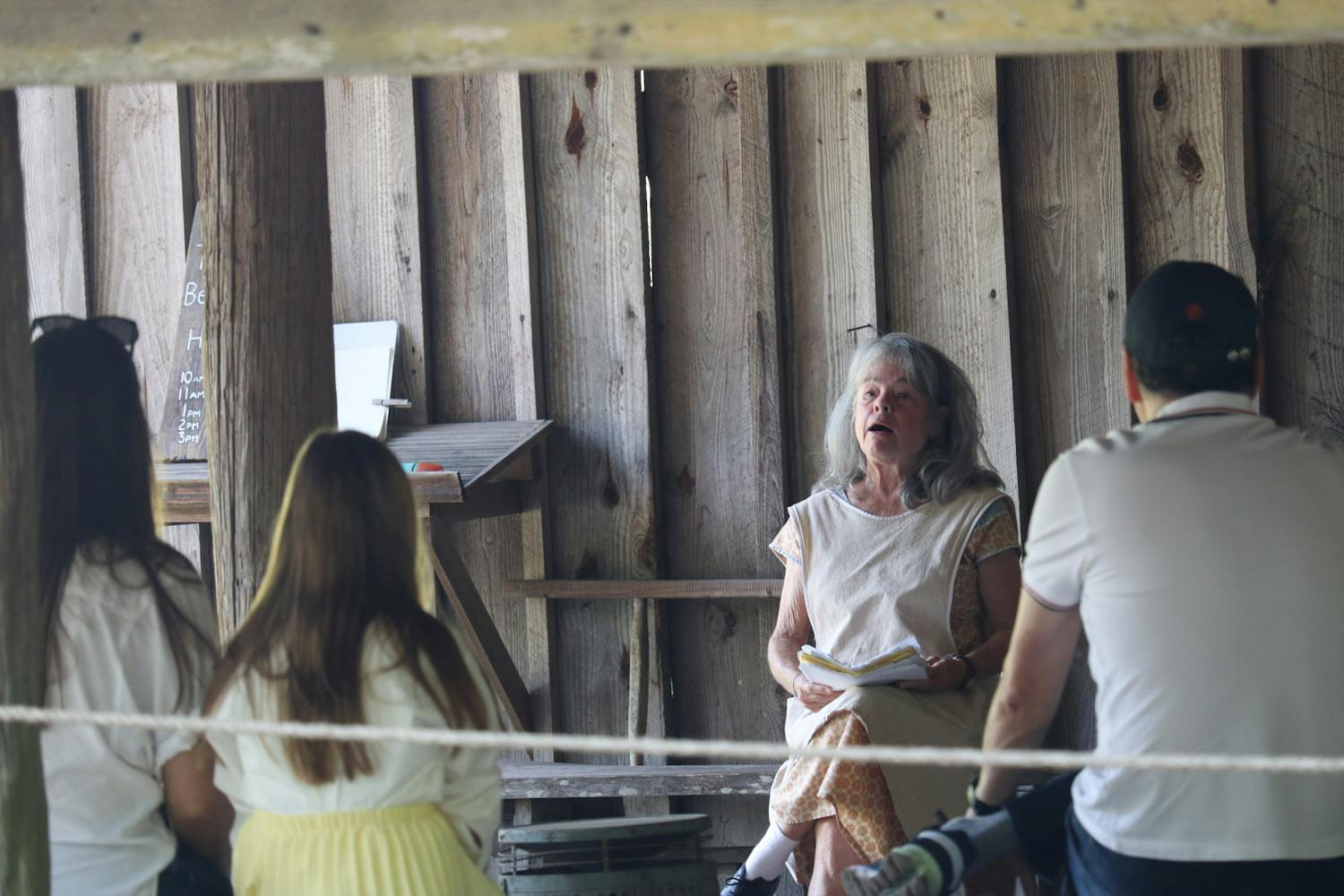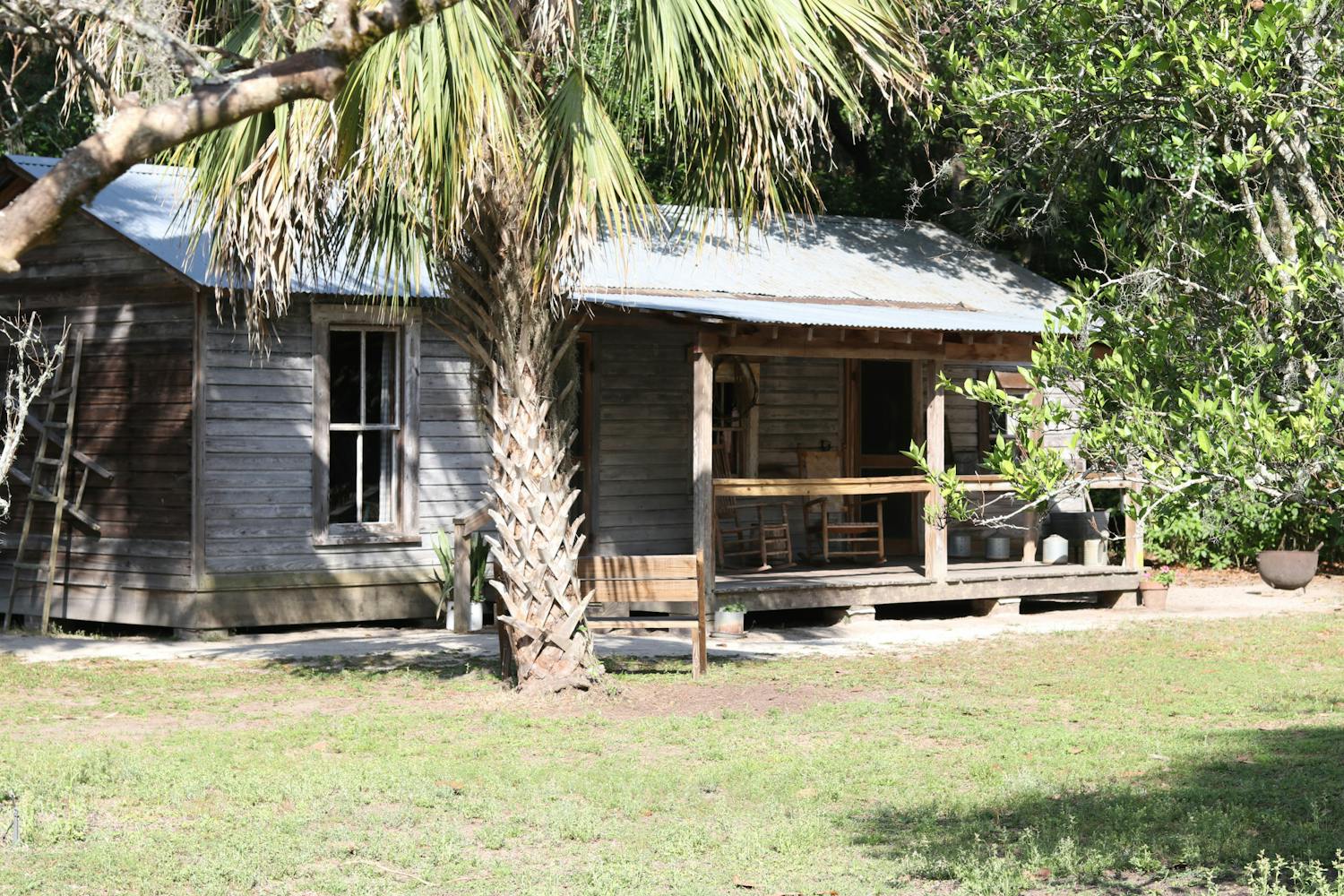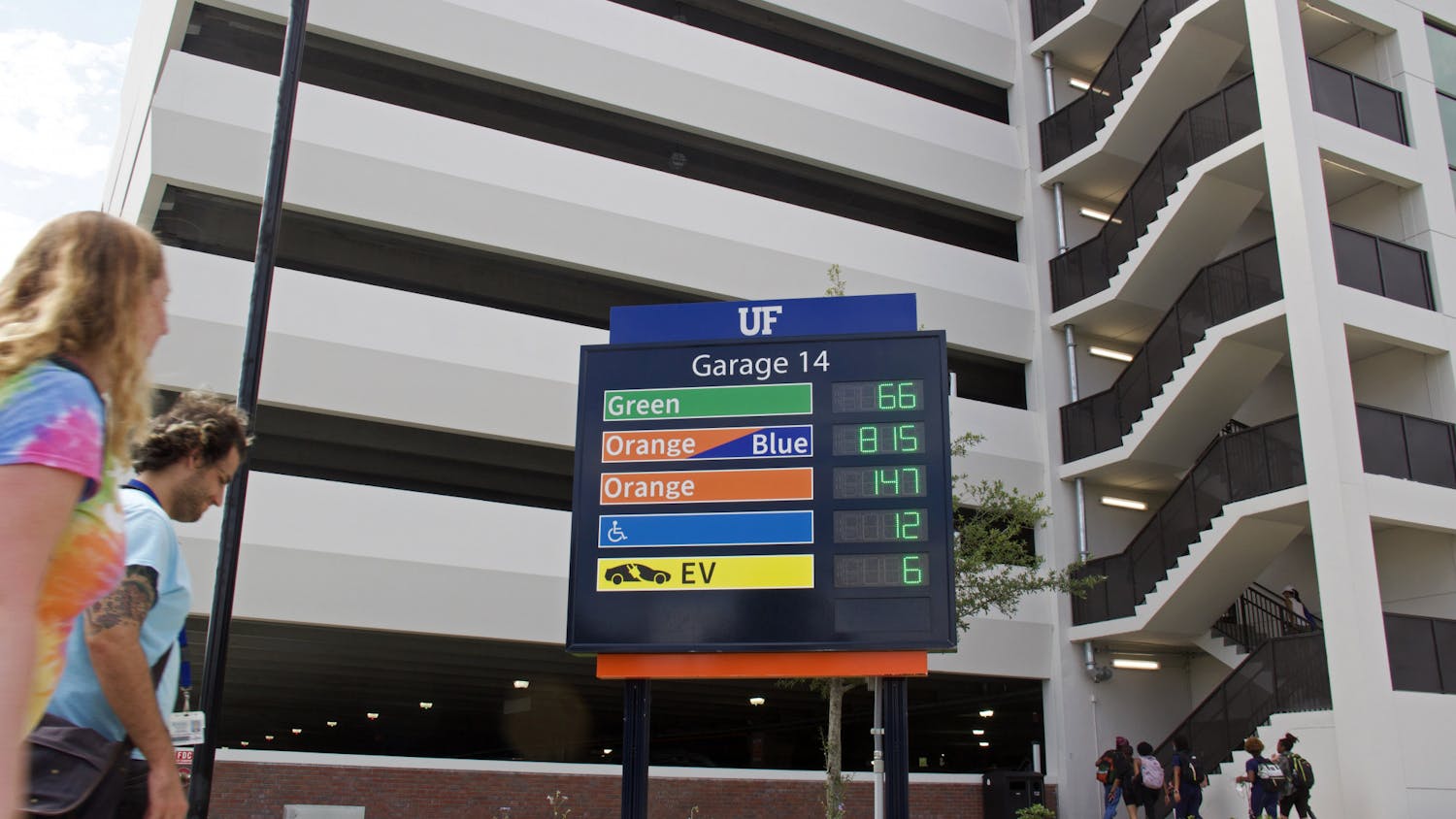Every morning before heading into the orange groves for his shift, Marjorie Kinnan Rawlings State Park tour guide Rick Mulligan reads one of the titular author’s letters. He tries to pick a letter that was written on the date he’s going in, to get a sense of how she was feeling that day.
With more than 1,400 letters at the Special and Area Studies Collections at George A. Smathers Libraries to choose from, 10-year-veteran tour guide Mulligan has plenty of options.
Rawlings — the earnest and masterful penwoman of “The Yearling,” “Cross Creek,” and “South Moon Under” — was a best-selling novelist of the 1940s. Characterized by her coarse tongue, descriptive vocabulary and environmental passion, the prize-winning author brushed elbows with some of the most renowned writers of her generation and was considered one herself.
Mulligan, 71, said he was entranced by the compelling emotion of Rawlings’ writings, gripping his mind since the first time he was required to read “The Yearling” in school.
“She’s able to put visual images in your mind,” Mulligan said. “Although the writing is very dense and you have to take time and explain these images … somehow, it captivated me.”
Born in Washington, D.C., Rawlings is best known for her appreciation of Florida’s wildlife and the natural ruggedness of central Florida. She lived and wrote some of her best-known work in the small Alachua unincorporated community Cross Creek for most of her adult life, before dying in St. Augustine in 1953.
Her home, located at 18700 South County Road 325, now serves as a museum and historic site, nestled between Orange Lake and Lochloosa Lake. The park grounds are open every day from 9 a.m. to 5 p.m.
In 1938, Rawlings won the Pulitzer Prize for Fiction for “The Yearling,” the Civil War-era drama about a young boy’s relationship with a fawn. The novel inspired a motion-feature adaptation 10 years later, shooting Rawlings to international fame. She also published a recipe book, “Cross Creek Cookery,” guiding readers through her deep-Southern culture — inspiring a Hawthorne restaurant named after the award-winning novel.
“Cross Creek,” an autobiography that recounts the rugged yet colorfully captivating details of Rawling’s farmhouse and life in “The Big Scrub,” the term she used for the swampy area behind her home. When she arrived, the rural area was remote — even more remote than it’s considered today — and sparse.
Rawlings was fascinated by the local backwoodsmen’s, affectionately dubbed “Crackers,” way of life. She observed them in what she called “invisible Florida,” not because of its inaccessibility, but because it must be seen with the spiritual eye. The locals taught her to fish and hunt for her own food, and she repaid them by honoring their culture in her writing.
Nostalgic bookworms, movie fanatics and wilderness admirers alike hail to Marjorie Kinnan Rawlings Historic State Park. Her wood-frame country home, with some of its oldest parts made in the mid-19th century, stands as a testimonial to the work Rawlings contributed to the world of literature.
The author briefly worked as a creative writing lecturer at UF. In 1958, UF named the student housing dormitory Rawlings Hall in her honor.
Guests describe the state park as an escape into the Old Florida wilderness, emoting a tugging feeling of nostalgia for an era that you haven’t lived — but feel like you could belong to.
The area was remote when Rawlings thrived there as a divorced writer. Only seven families lived in Cross Creek when she arrived.
The allure of isolation in the wilderness is an intriguing pull for many readers, idealizing the immersion experience.
Susan Meany, 71, drove up from the Winter Villages to visit the park with her group of biker friends Feb. 25. She read “The Yearling” in grade school, she said, and was inspired to buy “Cross Creek” after attending the tour.
“It was interesting how she would come back here,” Meany said. “She'd never got out of her element. She just always stayed right here.”
The federally-protected sanctuary allows wild rattlesnakes, ducks and sandhill cranes to roam freely as neighbors to employees like Geoff Gates.
Gates, 66, has been guiding detailed tours of Rawlings’ life for five years and is the resident gardener of Rawlings’ vegetable garden, which she maintained next to her home.
There’s no denying Rawlings’ work transformed the area of Cross Creek, Gates said. The area enriched her just as much as she impacted it.
“She was enormously changed by this place and the people that lived here,” Gates said. “The development of Cross Creek came from her famous writings. People wanted to be a part of it.”
At the peak of its popularity in the 1950s, the “Cross Creek”-inspiring home could have hosted over 40,000 visitors in a year, Gates said, with movie fanatics arriving in droves on buses to visit the literary hallmark.
“Hundreds, if not thousands, of people per day were coming here,” Gates said. “For several years after the movie premiered, it was absolutely a transformation of this place into a tourist mecca.”
Now with over 500 families living in the area, efforts have consistently been made to ensure
Cross Creek isn’t overcapitalized, ensuring the slice of Old Florida so many have come to love doesn’t change.
The “Big Scrub” Rawlings wrote of in “Cross Creek” is currently used by the fishing and agriculture industries surrounding the area for boat rentals, fishing, frog gigging and hunting in the surrounding lakes.
The boat ramp fishers use is located directly behind the state park and is named after Cross Creek artist, Kate Barnes, another conservationist who has made efforts since the 1980s to preserve the surrounding land and preserve the natural and cultural resources of the area, founding the citizen’s group The Friends of Cross Creek.
The group opposed the development of "Lochloosa New Town," a city of up to 200,000 people with proposed amenities including a regional shopping center, golf courses and marinas on both lakes.
At the time the development was proposed, there was one road in the town with no sewers, cable TV or town government. The Owens-Illinois Corporation dropped out of the development project after Alachua County passed the Cross Creek Special Area Study, a blueprint guideline with restrictions on developments within natural areas.
Some years later, The Friends of Cross Creek managed to protect 16,610 acres of forestry, in addition to 10,593 acres of lakefront property purchased with the help of the St. Johns River Water Management District.
In 2022, 605 acres of natural land area in Hawthorne was secured within the Florida Wildlife Corridor, containing over two miles of Lochloosa Creek by Alachua County Forever. The $1.5 million acquisition deemed the land worthy of special protection because of its exceptional ecological significance.
When Rawlings lived in Cross Creek, similar “big interests” were at odds with maintaining the beauty of the small rural town’s natural state; during her time, it was timber that was being overconsumed which led to Rawlings’ continually being asked to support the conservation of the land.
“The whole situation is maddening,” Rawlings wrote in a letter displayed in her home, “greed seems to make people totally blind.”
Rawlings’ protesting spirit is still felt in writing, even if now it’s no longer her own. Rawlings, along with Marjory Stoneman Douglas and Marjory Harris Carr, inspired “The Marjorie,” an independent environmental news outlet featuring pieces from local citizen journalists. The paper has won multiple awards and grants because of its coverage honoring the beauty and depth of Florida’s climate.
Over the course of her time at the farmhouse, Rawlings planted over 1,600 citrus trees across 73 acres of land.
Today, less than 50 remain.
Tour guide Peggy Bowie said other than this decline, the park hasn’t changed much — the citrus smell Rawlings was so fond of can still be faintly recognized through the palm fronds.
“A lot of the places that used to have orange groves when the freezes came and trees were killed, they just mowed it all down,” Bowie said. “I can't say that's true out there. If you look at Cross Creek, it doesn't look that different from the way it did when Rawlings was there.”
Bowie originally joined the state park team in 1983 as a park ranger, but she now volunteers as a tour guide. Although she carries a stack of notes to refer to throughout her presentation, she rarely uses them — instead relying on memorization and habit.
The decrease in trees, Bowie said, can be attributed to seasonal changes that are detrimental to the local orange populations, as well as generally decreasing temperatures.
“We’ve had these big freezes that’ve come through and just completely froze entire groves down,” Bowie said.
This past winter was the first time in recent history that a real freeze had taken most of the park’s orange crop, with Christmas night dipping down into the lowest temperature — a low of 23 degrees.
Orange grove farmer Andy Johnson has over 4,000 citrus trees in his Ocala field. He uses microjet irrigation technologies to protect against freezes like those from this past Christmas, he said, unlike the techniques seen in the “Cross Creek” movie when they set bonfires around the field to keep the citrus trees warm.
Something northern Florida farmers have to contend with while maintaining the health of their crops is citrus greening, Johnson said. Compared to the insect pressure a South Florida crop would receive, northern Florida citrus groves prefer to have a bit of the cold on their side to avoid citrus psyllids, disease-infected insects that transfer damaging bacteria.
“I would say we get changes, and this cold spell was unexpected,” Johnson said. “We're at the teetering point between wanting the cold and getting rid of the bugs and to stay warm enough to be able to crop.”
Despite the climate working against them, the staff at Rawlings State Park maintain the remaining citrus trees to the best of their ability to pay homage to Rawlings’ taste for beautiful sights.
The staff replanted the varieties Rawlings originally seeded, Mulligan said.
“You come out here today — you can smell the orange blossoms open,” Mulligan said. “It's all your senses can get.”
Contact Loren at lmiranda@alligator.org. Follow her on Twitter @LorenMiranda13.
Loren Miranda is a second-year journalism major and a staff writer for the Avenue. She is also a copy editor for Rowdy Magazine. When she's not writing, she enjoys watching either critically acclaimed films or cheesy reality TV, no in-betweens.


